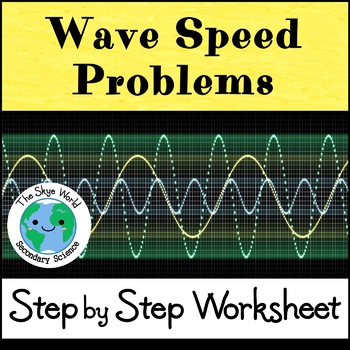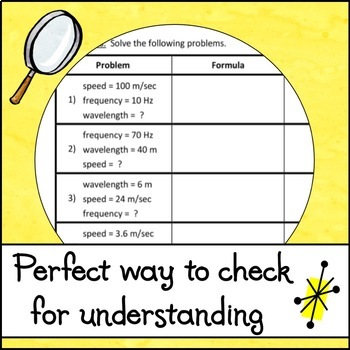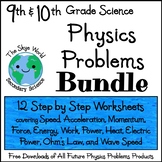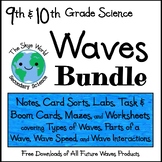Wave Speed Problems Worksheet
- PDF
What educators are saying
Also included in
- This bundle of worksheets will prepare students to solve simple physics problems including speed, acceleration, momentum, force, energy, work, power, power, heat, electric power, Ohm's law, and wave speed. By completing these activities, 9th and 10th grade science and conceptual physics science stPrice $24.00Original Price $36.00Save $12.00
- This bundle of lessons will prepare your 9thgrade physical science students to identify and describe longitudinal and transverse waves by properties including amplitude, wavelength, and frequency. Students will learn how to calculate wave speed problems using the variables velocity, frequency, and wPrice $24.00Original Price $36.00Save $12.00
- This mini-bundle of lessons will prepare your 9th grade physical science students to identify and describe longitudinal and transverse waves by properties including amplitude, wavelength, and frequency. Students will learn how to calculate wave speed problems using the variables velocity, frequency,Price $6.00Original Price $9.00Save $3.00
- This growing bundle covering a year of curriculum for 9th and 10th grade physical science (integrated physics and chemistry) includes the bundles of activities listed below. All lessons are aligned to the TEKS (Texas Knowledge and Skills). Bundles include notes, worksheets, card sorts, task cards,Price $274.00Original Price $420.00Save $146.00
Description
This worksheet will prepare students to solve simple problems including wave speed calculations. By completing this activity, 8th and 9th grade science students will learn how to calculate wave speed. Students solve problems using the variables velocity, frequency, and wavelength along with the metric units kilometer per hour, hertz, and meter.
Important Information
Do not allow students to use calculators or they will finish this activity too quickly. This is an opportunity for them to apply their basic math skills.
How it Works
This activity teaches students to show their work step by step with columns for formula, work, and answer with units. Students learn to set up word problems with ease. Complete instructions for your classes are included.
TEKS Covered
I. 5G
P.7B
NGSS Standards Covered
Materials Needed
pencil
This product is also part of the following money saving bundles
Related Resources
- Lab Activity – Relating Pitch and Frequency
- Properties of Waves Worksheet
- Card Sort Activity – Classifying Waves
Terms of Use – copyright ©Catherine Skye All rights to this product are reserved by author. This authorizes one teacher to use this product. If you want to share it with other teachers, please purchase a license to share this work. Copying by more than one teacher, classroom, department, school, or school system is prohibited UNLESS you purchase a license. Clipart and elements found in this PDF and others on my site are from the public domain unless otherwise noted. All products on my site are intended for classroom and personal use and may not be digitally copied for reuse in any form. Any misuse is considered copyright infringement and violates the DMCA (Digital Millennium Copyright Act).









